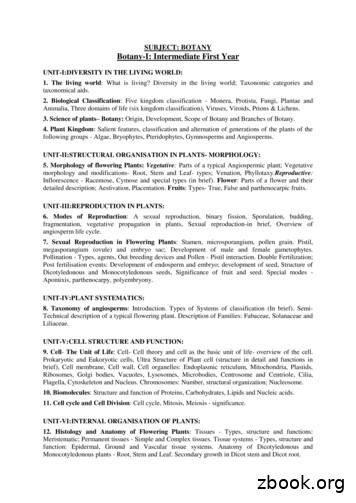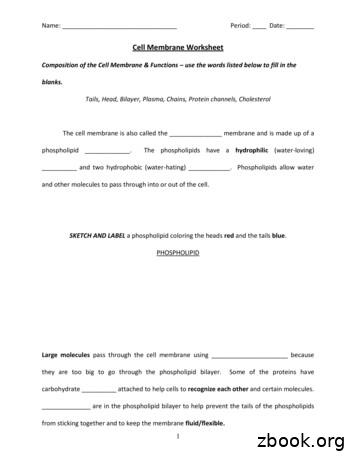Chapter 4: Cell Membrane Structure And Function
Chapter 4:Cell Membrane Structure and Function
Chapter 4: Membrane Structure and FunctionPlasma Membrane: Thin barrier separating inside of cell(cytoplasm) from outside environmentFunction:1) Isolate cell’s contents from outside environment2) Regulate exchange of substances between inside andoutside of cell3) Communicate with other cellsNote: Membranes also exist within cells forming variouscompartments where different biochemical processes occur
The Fluid Mosaic Model of Cellular Membranes:
Chapter 4: Membrane Structure and FunctionPhospholipid Bilayer: Double layer of phospholipids Hydrophilic ends form outer border Hydrophobic tails form inner layer Lipid tails of phospholipidsare unsaturated (C C)
Chapter 4: Membrane Structure and FunctionCell Membrane Proteins:1) Transport Proteins: Regulate movement of hydrophilic molecules throughmembraneA) Channel Proteins (e.g. Na channels)B) Carrier Proteins (e.g. glucose transporter)2) Receptor Proteins: Trigger cell activity when molecule from outsideenvironment binds to protein3) Recognition Proteins: Allow cells to recognize / attach to one another Glycoproteins: Proteins with attached carbohydrategroups
Chapter 4: Membrane Structure and FunctionHow are Substances Transported Across Membranes?Answer: Concentration GradientsConcentration Number of molecules in a given unit ofvolume (e.g. grams / liter; moles / liter)Gradient Difference between two regions of spacesuch that molecules move from one region tothe other
Chapter 4: Membrane Structure and FunctionDiffusion: Movement of molecules from an area of [high] to anarea of [low] Greater the concentration gradient, the faster diffusion occurs Diffusion will continue until gradient is eliminated (equilibrium) Diffusion cannot move molecules rapidly over long distances
Chapter 4: Membrane Structure and FunctionTypes of Movement Across Membranes:1) Passive Transport Requires no energy Substances move down concentration gradientsA) Simple Diffusion Small molecules pass directly through the phospholipidby-layer (e.g. CO2, H2O, O2)Rate depends on:1) Molecule size2) Concentration gradient3) Lipid solubility(Figure 4.3a)
Chapter 4: Membrane Structure and FunctionTypes of Movement Across Membranes:1) Passive Transport Requires no energy Substances move down concentration gradientsB) Facilitated Diffusion Molecules need assistance of channel proteins orcarrier proteins (e.g. ions, amino acids, sugars)Channel Proteins(Figure 4.3b)Carrier Proteins(Figure 4.3c)
Chapter 4: Membrane Structure and FunctionTypes of Movement Across Membranes:1) Passive TransportA) Simple Diffusion Requires no energyB) Facilitated Diffusion Substances move down concentration gradientsC) Osmosis Movement of water from an area of high [water] to areaof low [water] across semi-permeable membranewater
Chapter 4: Membrane Structure and FunctionOsmosis:water
Chapter 4: Membrane Structure and FunctionOsmosis and Living Cells:Isotonic Solution: Outside of cell has same [solute]as inside of cell(no net water movement)
Chapter 4: Membrane Structure and FunctionOsmosis and Living Cells:Isotonic Solution: Outside of cell has same [solute]as inside of cellHypertonic Solution: Outside of cell has higher [solute]than inside of cell(net water movementout of cell)
Chapter 4: Membrane Structure and FunctionOsmosis and Living Cells:Isotonic Solution: Outside of cell has same [solute]as inside of cellHypertonic Solution: Outside of cell has higher [solute]than inside of cellHypotonic Solution: Inside of cell has higher [solute]than outside of cellTonicity is relativeto the inside of the cell(net water movementinto cell)
Chapter 4: Membrane Structure and FunctionTypes of Movement Across Membranes:1) Passive Transport2) Active Transport Requires energy (ATP) Substances move against concentration gradients
Chapter 4: Membrane Structure and FunctionTypes of Movement Across Membranes:1) Passive Transport2) Active Transport3) Endocytosis Movement of large particles into cells (vesicle formation)1) Pinocytosis (“cell drinking”) Uptake of fluid droplets2) Receptor-mediated Endocytosis: Uptake of specific molecules via coated pits3) Phagocytosis (“cell eating”) Uptake of large particles (e.g. bacteria)
Chapter 4: Membrane Structure and FunctionEndocytosis:(Figure 4.7)
Chapter 4: Membrane Structure and FunctionTypes of Movement Across Membranes:1) Passive Transport2) Active Transport3) Endocytosis4) Exocytosis Movement of large particles out of cells (e.g. hormones)
Chapter 4: Membrane Structure and FunctionExocytosis:(Figure 4.9)
Chapter 4: Membrane Structure and FunctionHow are Cell Surfaces Specialized?Answer: Junctions allow cells to connect and communicate1) Connection Junctions:A) Desmosomes: Hold cells together via protein filaments(Figure 4.10a)
Chapter 4: Membrane Structure and FunctionHow are Cell Surfaces Specialized?Answer: Junctions allow cells to connect and communicate1) Connection Junctions:B) Tight Junctions: Protein “seals” prevent leakage (cell cell)(Figure 4.10b)
Chapter 4: Membrane Structure and FunctionHow are Cell Surfaces Specialized?Answer: Junctions allow cells to connect and communicate2) Communication Junctions:A) Gap Junctions: Protein channels allowing for signals topass between cells (animals)(Figure 4.11a)
Chapter 4: Membrane Structure and FunctionHow are Cell Surfaces Specialized?Answer: Junctions allow cells to connect and communicate2) Communication Junctions:A) Plasmodesmata: Cytoplasmic bridges allowing forsignals to pass between cells (plants)(Figure 4.11b)
Chapter 4: Membrane Structure and FunctionHow are Cell Surfaces Specialized?Answer: Cell walls offer support and protectionCell Walls: Found in bacteria, plants, fungi, & some protists Composed of carbohydrates (e.g. cellulose, chitin),proteins, or inorganic molecules (e.g. silica) Produced by the cell it protects/supports
Chapter 4: Membrane Structure and FunctionCell Wall:(Figure 4.12)
Chapter 4: Membrane Structure and Function How are Cell Surfaces Specialized? Answer: Cell walls offer support and protection Cell Walls: Found in bacteria, plants, fungi, & some protists Composed of carbohydrates (e.g. cellulose, chitin), proteins, or inorganic molecules (e.g. silica) Produced by the cell it protects/supports
Part One: Heir of Ash Chapter 1 Chapter 2 Chapter 3 Chapter 4 Chapter 5 Chapter 6 Chapter 7 Chapter 8 Chapter 9 Chapter 10 Chapter 11 Chapter 12 Chapter 13 Chapter 14 Chapter 15 Chapter 16 Chapter 17 Chapter 18 Chapter 19 Chapter 20 Chapter 21 Chapter 22 Chapter 23 Chapter 24 Chapter 25 Chapter 26 Chapter 27 Chapter 28 Chapter 29 Chapter 30 .
UNIT-V:CELL STRUCTURE AND FUNCTION: 9. Cell- The Unit of Life: Cell- Cell theory and cell as the basic unit of life- overview of the cell. Prokaryotic and Eukoryotic cells, Ultra Structure of Plant cell (structure in detail and functions in brief), Cell membrane, Cell wall, Cell organelles: Endoplasmic reticulum, Mitochondria, Plastids,
TO KILL A MOCKINGBIRD. Contents Dedication Epigraph Part One Chapter 1 Chapter 2 Chapter 3 Chapter 4 Chapter 5 Chapter 6 Chapter 7 Chapter 8 Chapter 9 Chapter 10 Chapter 11 Part Two Chapter 12 Chapter 13 Chapter 14 Chapter 15 Chapter 16 Chapter 17 Chapter 18. Chapter 19 Chapter 20 Chapter 21 Chapter 22 Chapter 23 Chapter 24 Chapter 25 Chapter 26
Cell Membrane Worksheet Composition of the Cell Membrane & Functions – use the words listed below to fill in the blanks. Tails, Head, Bilayer, Plasma, Chains, Protein channels, Cholesterol The cell membrane is also called the _ membrane and is made up of a phospholipid _.
Unit 2 Student Notes Page 7 Basic Structure of Eukaryotic Cells 1. Plasma “cell” membrane --This holds the cell together. The eukaryotic cell membrane is very similar to the prokaryotic cell membrane. The membrane is important for transporting substances into and out of the cell. 2.
Chapter 7 Cell Structure & Function 1. The Cell Theory 1. All living things are made up of cells. 2. Cells are the basic unit of structure & . membrane a tough, flexible structure; forms a barrier between cell & its surroundings. Cell Membrane Protein Channels & Pumps: embedded in
KEY CONCEPTS 3 Cell Structure and Function 3.1 Cell Theory Cells are the basic unit of life. 3.2 Cell Organelles Eukaryotic cells share many similarities. 3.3 Cell Membrane The cell membrane is a barrier that separates a cell from the external environment. 3.4 Diffusion and Osmosis Mat
the bulk phase through the membrane into the permeate stream (Di et al., 2017). 3. Membrane Integration on chip It is crucial to apply a membrane (i.e. material and type) that best fits the targeted application. Membrane properties differ from one membrane to another and they greatly affect the overall membrane separation efficiency.























